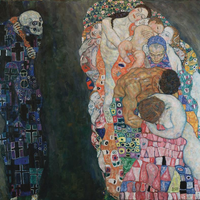More about Cry Dragon/Cry Wolf: The Ark of Genghis Khan

Contributor
In Cry Dragon/Cry Wolf, Cai Guo-Qiang pokes at the American fear of Asian expansionism.
To be fair, we do get pretty darn touchy about it. Since the late nineteenth century, American culture has been pretty vocal on the racist phenomenon known as “Yellow Peril”-- the vague, existential fear that Asian culture will somehow undermine and ultimately destroy the "pure" American way of living. Though we tend to be pretty okay with consuming Asian food, culture, and music (looking at you, BTS), the thought of any kind of Asian dominance or expansion strikes fear deep into our good ‘ol American hearts. So far, in fact, that Cai Guo-Qiang thought it was worth a whole room-size art piece.
Even though he’d been working as an artist for over a decade at the time of its debut, the 1996 display of Cry Dragon/Cry Wolf was Guo-Qiang’s first major American showing; he was a finalist in the very first year of the now-very-fancy-and-well-known Hugo Boss Prize. While the prize ended up going to notably bonkers American artist Matthew Barney, Guo-Qiang’s work struck a chord with American audiences and he began to build a reputation for his massive, site-specific work. By the time the early 2000s rolled around, he had secured a place for himself in the Western art world.
Using rope, branches, paddles, and 108 inflated sheepskins— material traditionally used by Mongolian warriors as rafts— Guo-Qiang creates a long, sloping arc that ends with three running Toyota engines. It doesn’t necessarily look like a dragon in a literal, saw-it-on-a-ride-at-Disney kind of way, but it does create an effect similar to the traditional dragons shown in Chinese festivals during the Lunar New Year.
There are a whole lot of juxtapositions to unpack here (ancient vs. modern! nature vs. machine!) but one of the easiest ones to spot isn’t found in the physical sculpture at all, but in its very name: “Cry Dragon/Cry Wolf.” If you ever went to American kindergarten, you probably read a children’s collection of Aesop’s fables and stumbled upon the idiom “Cry Wolf," an expression of danger when none actually exists. By juxtaposing “Cry Wolf/Cry Dragon”, Guo-Qiang pointedly refers to the similarity between the hysterics of the boy in the story and the American tendency to freak out about Asian expansionism, even if it doesn’t actually pose a threat. It’s kind of a great jab at our ‘Murican priorities.
Sources
- Editors, A. (2018, January 26). Detonating cultural BORDERS: An interview with cai guo-qiang. Artspace. https://www.artspace.com/magazine/interviews_features/book_report/deton….
- Kuo Wei Tchen , J., & Yeats, D. (2016, July 26). Yellow Peril: 19th-century Scapegoating. Asian American Writers' Workshop. https://aaww.org/yellow-peril-scapegoating/.
- Roy, K. (n.d.). A global history of Pre-Modern Warfare: Before the Rise of the West, 10,000 BCE–1500 CE . World History Encyclopedia. https://www.worldhistory.org/books/0367247178/.
- SoHo Guggenheim • CAI GUO. Qiang. (2019, February 24). https://caiguoqiang.com/projects/projects-1996/soho-guggenheim/.













